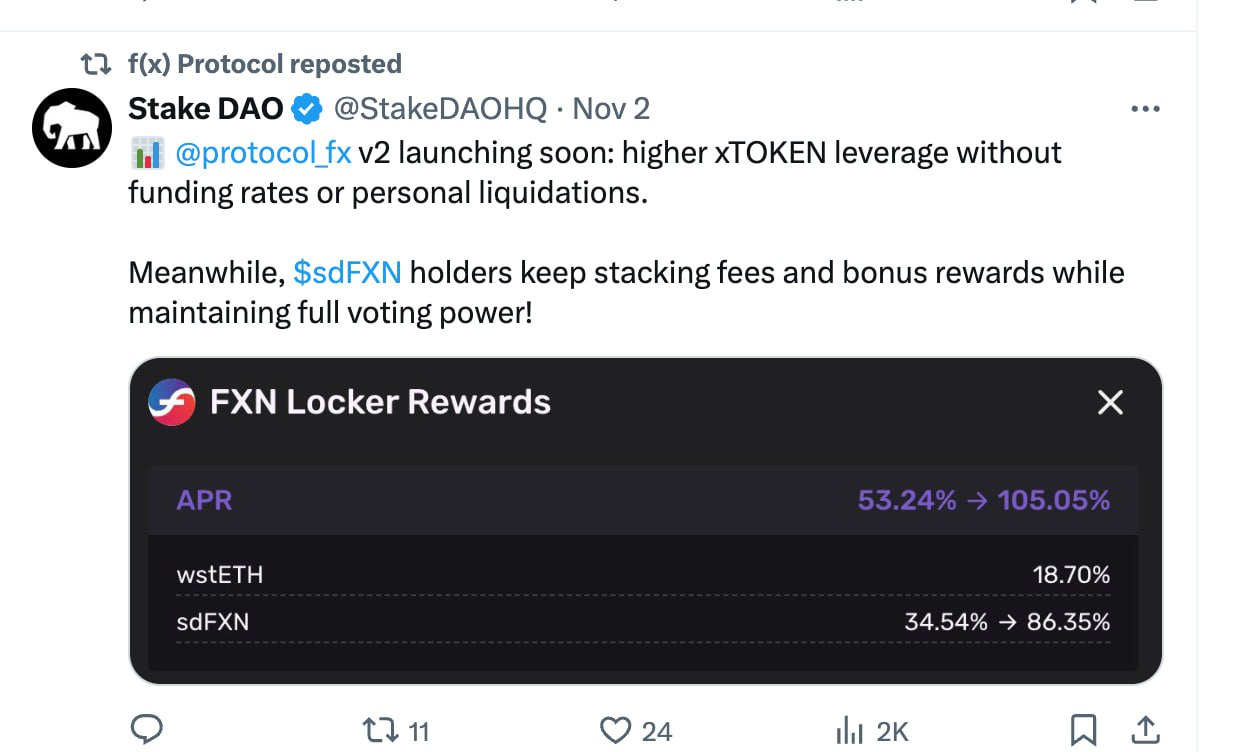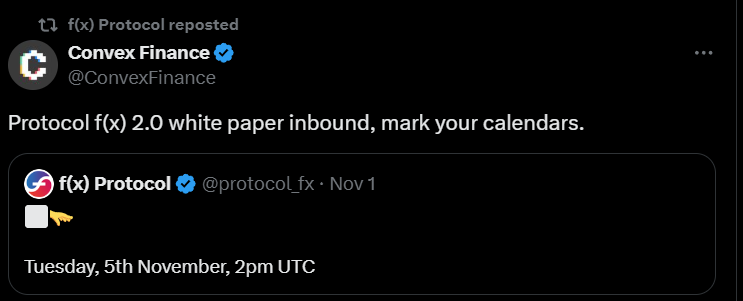Author: Kazuma, the Researcher from BlockBooster
Most decentralized stablecoins on the market today tend to be inefficient and often require overcollateralization, primarily to cope with the high volatility of the underlying reserve assets. This inefficiency limits the scalability of stablecoins, making them difficult to Crypto users use it daily. If there is a stablecoin that can strip away some of the volatility and provide it to users who seek higher returns, will users be more willing to accept it?
f(x)Protocol is a new DeFi protocol that achieves this goal by splitting collateral assets into low volatility tokens and high volatility tokens. The low volatility tokens support its stablecoins, while the high volatility tokens Volatility tokens enable users to gain exposure to price fluctuations of underlying assets through leverage. The protocol’s core stablecoin, fxUSD, is pegged to the U.S. dollar, built on an innovative split-token mechanism, and uses ETH as the underlying collateral asset.
f(x)Protocol’s growth performance in 2024
In 2024, f(x)Protocol’s total locked value (TVL) increased by 273% from $15 million to $56 million today. At the same time, the platform has also launched a variety of products based on the same mechanism but using different collateral assets. Stablecoins, such as:
- rUSD: Backed by Liquid Retention Tokens (LRTs)
- btcUSD: Backed by Bitcoin
In addition, in June 2024, f(x)Protocol launched arUSD, an automatic compounding version of rUSD, which allows users to earn additional income from the underlying LRT assets.
As the DeFi sector recovers, f(x)Protocol is preparing for the release of V2 in December 2024 and has previewed some of the contents of its white paper. Project partners such as StakeDAO and Convex are also looking forward to the V2 version.


(Source: X)
f(x)Protocol Newly Released V2 White Paper Highlights
On November 5, f(x)Protocol released the V2 white paper, which shifted the focus more towards leveraged xPositions as a means to promote the effective use of fxUSD. The following are the key features:
1. Higher leverage:
The V1 version of xPositions allows users to obtain underlying assets with variable leverage through X-token, but the leverage ratio will fluctuate according to the market demand for fxUSD. In the V2 version, users can directly open fixed leverage xPositions with a leverage ratio of up to 10 times. And there is no need to mint X-token in the wallet. In order to support higher leverage and maintain the stability of the system, the protocol automatically mints a certain amount of fxUSD through flash loans to ensure that the total collateral of X-token is in the leverage ratio selected by the user. match.
2. No single point liquidation risk:
The V2 version introduces a rebalance mechanism. When the risk of xPositions approaches the liquidation threshold, the system will automatically redeem part of the minted fxUSD, thus avoiding the risk of "explosion" common in traditional DeFi protocols.
3. Delta-Neutral stable pool based on USD:
The V2 version introduces a new Stability Pool, where users can deposit USDC or fxUSD with one click, providing liquidity support for the stability of the protocol. Unlike the V1 version’s Stability Pool, the V2 version’s Stability Pool acts as a stable platform for USDC and fxUSD. The anchored stabilizer between the two ensures that the value of user deposits is denominated in US dollars. Through the V2 version of the stable pool, participants can earn income in the following ways:
- Price arbitrage in the fxUSD/USDC AMM pool
- Trading and rebalancing fees paid by X-token traders
There is no need to execute or manage complex strategies during the entire process. The operation is simple and easy to use, and the source of income is more transparent.
4. “Zero Funding Fees” for Specific Assets:
Version V2 provides a “zero funding fee” design for some specific assets, further reducing users’ transaction costs.
How fxUSD works
To better understand these innovative mechanisms and how they will help fxUSD truly become a scalable, high-yield decentralized stablecoin, let’s take a deeper look at the current state of the f(x) protocol and its underlying technology.
f(x)Protocol adopts a dual-token mechanism, splitting the underlying assets into fxUSD (stable currency) and xPositions (leverage). In the V1 version, users need to deposit collateral assets before they can mint fxUSD or X-token ( xPositions). In the V2 version, users can directly exchange assets for fxUSD through the CowSwap aggregator. In addition, the V2 version allows users to directly open xPositions without going through the step of minting X-tokens, further simplifying the operation process.
The core mechanism of fxUSD:
- Users deposit stETH into f(x)Protocol to mint fxUSD or xPositions, and the assets are backed by the underlying USD assets.
- As the price of the underlying asset changes, the value of the reserve redeemable by users will also change, but xETH (X-token) will first bear the volatility to make up the difference.
- When the price of ETH drops, the value of the X-token will drop in a greater proportion, as xETH is equivalent to a leveraged position, while fxUSD maintains its peg to the USD.
- When the price of ETH rises, the system remains fully collateralized and xPosition holders enjoy leveraged returns.
To further maintain the stability of fxUSD, users can deposit stablecoins of liquid assets into the stability pool to obtain native staking returns in stETH, as well as emissions in the form of the protocol’s native FXN token, which includes trading and rebalancing fees in V2 .
f(x)Protocol’s unique advantages
In the highly competitive decentralized stablecoin market (such as DAI, LUSD), f(x)Protocol has achieved rapid growth through the following innovative designs:
1. No need for over-collateralization:
Unlike other decentralized stablecoins that rely on over-collateralization to cope with asset volatility, f(x)Protocol uses a dual-token design of fxUSD (stablecoin) and X-token (xPositions) to concentrate volatility on X-token. Thus, a stable leverage pairing is formed. fxUSD can therefore be stably anchored at a 1:1 ratio.
2. Diversified but segregated reserve support:
fxUSD's reserves are composed of many whitelisted liquid staking tokens (LSTs), which are supported by the stable pool of these tokens. But at the same time, the main reserve of fxUSD is separated from the LST stable pool, which not only reduces the risk of a single asset, but also ensures Capture arbitrage opportunities brought about by LST price fluctuations.
3. Incentives and stability are consistent:
It is a common practice to return the staking income of LST directly to the depositors, regardless of whether the stablecoin is circulated within the protocol. However, f(x)Protocol has made an innovation by distributing part of the income to users who hold fxUSD and participate in maintaining the stability of the protocol. , which helps the health and development of the protocol.
4. Simplified real benefits:
fxUSD provides users with an efficient way to earn multiple returns from the underlying stETH reserve, combined with inflation rewards for FXN tokens, which will be fully released into circulation within 50. In addition, X-token transaction fees in V2 will be further Driving sustainable revenue growth for stablecoins, such as opening/closing xPosition, and maintaining their liquidation fees
To further protect the peg of its stablecoin, f(x) also employs a unique risk management mechanism:
- X-token is the first line of defense : it can absorb market price fluctuations and protect the stability of F-token (stablecoin), while also providing a leveraged product for crypto players who seek high risk and high returns.
- What if X-token can’t hold up? If the price fluctuates too much and exceeds the tolerance of X-token, the protocol will redeem some F-token from the stable pool. This is similar to a “liquidation” for users. ", you need to repurchase the underlying collateral assets at the current market price. However, in order to compensate for this risk, the protocol will encourage users to participate in staking through underlying asset returns and token rewards.
- What happens in extreme cases? In a black swan event or market crash, X-token will not be destroyed directly like traditional liquidation, but will be reset to zero (value cleared). At this time, F-token will become the only Request the token of the underlying reserve asset. This also means that F-token will fluctuate 1:1 with the underlying asset.
Comparison of fxUSD and other stablecoins
Most of the major stablecoins on the market today are pegged to the U.S. dollar and rely on almost identical mechanisms to maintain this peg. However, they tend to differ in terms of collateral type, market size, and degree of integration with the broader crypto ecosystem. Here is a comparison of fxUSD with other stablecoins in several key aspects:
| fxUSD | Other stablecoins (such as DAI, USDC) | |
| Collateral assets | Liquid pledge assets such as stETH, LRT, and DeFi tokens | DAI relies on ETH; USDC/USDT relies on traditional financial assets |
| Mortgage Rate | 1:1 fully collateralized, no over-collateral required | Usually 110%-150% overcollateralization is required |
| Adoption level | Currently mainly used in the Ethereum ecosystem, gradually expanding integration with DeFi protocols (Spectra, StakeDAO and Convex Finance) | Widely integrated in CEX and DEX, covering multiple public chains |
| Price stability | fxUSD keeps assets largely pegged and stable, but has not yet been fully tested by the market | Stablecoins such as USDC and USDT are backed by assets such as U.S. Treasuries, but have also been unpegged during extreme market fluctuations. |
| Market Cap | fxUSD has a circulating market value of $10 million, with huge room for growth | DAI's circulating market value exceeds $3.3 billion |
Risks and Challenges of f(x)Protocol
As mentioned earlier, launching a new stablecoin in such a competitive environment is not easy, and f(x) Protocol faces several obstacles in its efforts to increase the ecological application of fxUSD:
- Fierce market competition: fxUSD still has a large gap in market value and market application scope compared with old stablecoins such as DAI and USDT. However, after the V2 version upgrade, f(x) tried to promote fxUSD as a "real return" (Real Yield) and focuses on optimizing its X-token product. The fees generated by X-token traders create a sustainable revenue flywheel for f(x), attracting more users with idle funds. This will not only drive f(x) )’s ecosystem grows and increases fxUSD’s adoption in the process.
- Potential risks of new protocols: As an emerging protocol, its mechanism has not been fully stress-tested in the actual market and there are potential risks.
- Ecosystem Application: The established stablecoin has been widely integrated in various DeFi protocols and blockchain ecosystems, making it highly practical in a wider range of scenarios, such as lending platforms. fxUSD currently only supports the Ethereum ecosystem, and its application scenarios Limited, lack of cross-chain and broader DeFi integration. However, the protocol stable pool provides higher yields than other platforms, which helps drive the growth and application of fxUSD
Despite the challenges, f(x)Protocol is gradually providing new value propositions for Web3 users through its innovative design of zero liquidation risk leverage and multi-yield stablecoins. In the future, with the launch of V2, f(x)Protocol is expected to further Expand market share and become an important player in the field of decentralized stablecoins.












